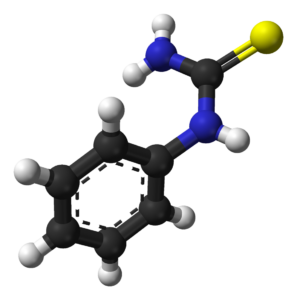Some of the best scientific experiments come to us by accident, and PTC is no exception. In 1930, Arthur Fox had a lab accident while purifying phenylthiocarbamide (PTC) that he had just synthesized. A plume of fine dust rose into the air, and suddenly, his colleague nearby started complaining of the bitter taste of the compound. Since Fox was the one working with the material, he had been exposed to much more of it, yet he experienced no such taste. Thus, began the research of PTC and its relation to genetics.
Fox and his colleague tasted the PTC again, and carried out the test with other colleagues, family and friends. Incidentally, many chemists followed suit of Fox, and began tasting new compounds they had synthesized until well into the 20th century. As you might suspect, accidental poising was a common cause of death among chemists.

Mendelian Genetics
Geneticists determined that the ability to taste PTC is an inherited trait. The correlation was so strong, that along with blood type, PTC was even used in paternity testing before DNA analysis came along. Amazingly, it took scientists years to determine why some people can taste PTC and some cannot. In 2003, they discovered that the gene, TAS2R38, determines the ability to taste PTC.
There are two common alleles of the gene TAS2R38, one for tasting and one for non-tasting (along with several other rare alleles). Everyone has two copies of each gene, but some individuals may have two copies of the tasting gene, while others may have two copies of the non-tasting gene, or one of each. This is why categorizing the taste of PTC from extremely bitter, to moderately bitter, to slightly bitter or tasteless is important. Individuals who have two copies of the tasting gene will obviously have a very strong reaction to the PTC, categorizing the taste as extremely bitter. Depending on where you fall on the tasting spectrum, you’ll know if you have both tasting, both non-tasting, or one of each gene.
![]()
There is some debate that the TAS2R38 gene is the only reason for tasting PTC, and that perhaps one of our other 30 genes has some code for this as well.
In addition, scientists believe that the ability to taste PTC is a selective advantage because these individuals can detect the bitterness of many alkaloids, which can be extremely toxic. This has led scientists to question why non-tasters weren’t long ago eliminated by unintentionally poisoning themselves from consuming toxic plants. Geneticists still debate why this has not occurred, but some believe that non-tasters are able to taste other toxic compounds that tasters cannot.
Experiment
 Using PTC taste test papers, test as many individuals as you can. Testing unrelated individuals, like friends, teachers, colleagues, etc. will provide some useful information, but it’s best to test as many relatives as possible to follow the inheritance of PTC tasting/non-tasting. Start by testing both of your parents and any siblings you may have. Then test your grandparents, all four if you can. Even better, test all of your extended family (aunts, uncles, cousins).
Using PTC taste test papers, test as many individuals as you can. Testing unrelated individuals, like friends, teachers, colleagues, etc. will provide some useful information, but it’s best to test as many relatives as possible to follow the inheritance of PTC tasting/non-tasting. Start by testing both of your parents and any siblings you may have. Then test your grandparents, all four if you can. Even better, test all of your extended family (aunts, uncles, cousins).
When you find volunteers to take the test, do not tell them what to expect, as this could result in false positives. It’s also best to instruct volunteers that there is no harm or hazard involved in taking the test.
Ask your volunteers on an individual basis to place one PTC taste test paper on their tongue, then ask them to describe what, if anything, they taste. Sometimes, the reaction may not be immediate. It may take a few seconds to get a result.
You’ll find that some people have extreme reactions to the PTC, while others have no reaction. Ask the volunteer to characterize their experience as extremely bitter, strongly bitter, mildly bitter, slightly bitter, or tasteless. Record all results in your laboratory notebook.
Once you have completed the test with all of your subjects, try making a genealogy chart for each of your family groupings, and see if you can track PTC tasting through the generations.
Questions
Now, answer these questions:
Based on your results, can you conclude that the ability to taste PTC is a full Mendelian trait? Why or why not?
Typically, in human studies, the identity of test subjects remains anonymous. How do you propose doing this with your own data? What overriding factors must you take into account when anonymizing your data?







Leave A Comment